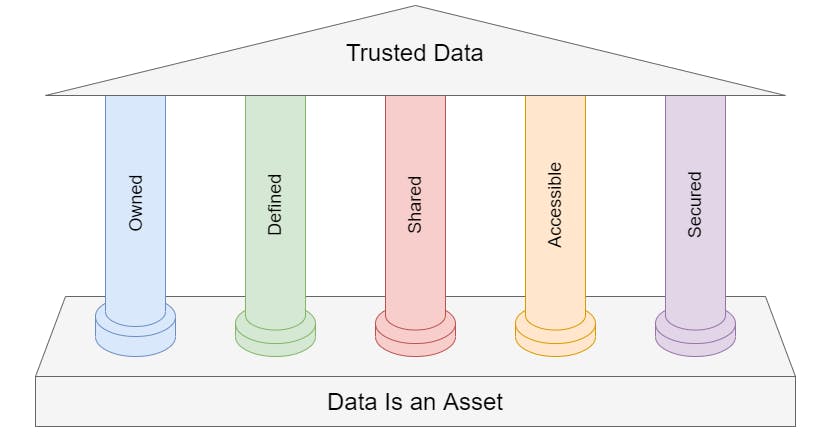When we think data, it’s common to start in the technical sphere. It’s the fun part. Besides, every data solution will have technology – so we want to jump right in! But before we can start to even discuss the warehouse, we must first agree upon a common set of core principles.
We must align around the Data Governance.
First, we must decide what ‘Data Governance’ is. This is my definition.
Data Governance exists to create mature trusted data through process and standards that drive business outcomes to accomplish corporate strategy.
To take this from a top-down approach, the company’s board and executive team are responsible for formulating the corporate strategy. Then, leadership determines which business outcomes are necessary to accomplish that strategy. Many times these outcomes are quantified into KPIs. Once the key business outcomes have been decided, Data Governance needs to support these outcomes with trusted data. Governance will build data processes and standards that generate mature data that can be trusted.
- Maybe new data needs to be captured to accurately report on the KPIs.
- Sometimes there are Data Quality issues and new processes need to be established to identify and remediate the data issues as they are captured.
- Perhaps new shared data sets are needed for different departments to get visibility into their metrics.
- Employees might need tools and services that enable them to build their own reports and ad-hoc queries.
- It's possible everyone needs better training and visibility into the data solutions provided to them.
Data Governance can and should engage in activities to tackle all of these issues. Often data consumers come up against organizational issues that make data analytics difficult. Many times they have to code or work around them, sacrificing quality in order to get something done. But with Data Governance, the company can address the issues at the source and fix the root of the problem.
How does Data Governance do this?

First, Data Governance cannot do its job without one very important thing:
Data must be viewed as an Asset.
This is a corporate culture issue. The whole company needs to consider their data a valuable asset – and manage it accordingly. Once this foundation is established, Data Governance can do its part.
These are the five Data Governance pillars that support trusted data.
Data Is Owned – Business leaders are accountable for their data.
Data is Defined – A consistent definition is created for each key data element, commonly understood by the whole company.
Data is Shared – Create once, then distribute. Rather than duplicate and independently manage data by multiple teams, a single source of entry is established and data is copied to other applications that need it. This keeps data from getting out of sync and mismanaged by groups that do not own their own data. (Interestingly enough, this requires the data owners to consider the needs of other groups in the company. Without faith that the owner will manage their needs appropriately, another team will be tempted to maintain their own set of the same data.)
Data is Accessible – Data should be intrinsically easy to share, find and access.
Data is Secured – Data should be protected from unauthorized use and access.
As an aside, the last two – Accessible and Secured – can often be viewed as opposing pillars, but they shouldn’t be.
In lieu of determining the proper audience for data, we have historically opted to lock it up. We restrict access, so we know it won’t be seen by anyone who shouldn’t see it. Conversely, employees often struggle to get access to data they need for their job. Especially if they need data from multiple sources, they spend large portions of their day gathering and preparing data instead of analyzing it.
Instead of making individual decisions every time someone needs a particular piece of data, we should define the audience for our data up front, tie that audience to a role and secure the data to the role. Then a user only needs to receive the appropriate role, and they can access all data under that role. So in practice, we secure the data (by determining the data’s audience/role), and we make it accessible (by assigning users to roles). With this perspective, it's impossible to access data without first securing it.
With this perspective, it's impossible to access data without first securing it.
By promoting these pillars, Data Governance can do their job to support trusted data throughout the enterprise. It doesn’t happen overnight, and one could argue the work is never completely finished. That’s why prioritization should be set by business needs – with the goal of driving business outcomes that accomplish the corporate strategy.
Every decision for the warehouse will be filtered through the lens of Data Governance. These pillars will drive the architecture and standards for the Governed Warehouse. By doing this, we will ensure the data in the warehouse will be trusted and drive strategic value for the organization.